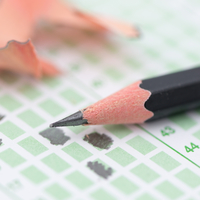One essay and 90 questions. That’s a lot to pack into three hours and 30 minutes of a GMAT exam. In addition to the Analytical Writing Assessment, there are a variety of question types on the GMAT. The basic categories to prepare for are the Integrated Reasoning, Quantitative, and Verbal sections of the GMAT. Let’s take a closer look at each of the question types found in those sections and consider ways to approach them.
Integrated Reasoning
Reasoning skillsare crucial to success on the GMAT. Like the essay, the Integrated Reasoning section is scored separately and does not count toward your total score. You have 30 minutes to answer the 12 multi-part questions, which cover the following areas: Multi-Source Reasoning, Graphics Interpretation, Two-Part Analysis, and Table Analysis. You must answer all parts of the questions correctly on the page to get any credit, as there is no partial credit.
In this section, as in all sections, pace yourself. Don’t necessarily spend time on all 12 questions. Read the material in front of you, make an analysis, select the best answer, and move on. If you’re completely stumped, take your best guess, and use your energy on another question that you have a better chance of getting right.
Problem-Solving
在定量section, the general math areas covered are Arithmetic, Algebra, Geometry, and Word Problems. In this section, you have two basic types of questions: Problem Solving and Data Sufficiency. A Problem Solving question is a multiple choice math problem with five answer choices. To find the correct answer, first, read the question. Then, as you go through the solution process, use the answer choices to guide you in the right direction. Don’t try to solve all of the math in your head. Do your calculations on the sheet provided and remember, the answer is on the page — you just have to find it.
Data Sufficiency
Questions involving Data Sufficiency cover the same mathematical areas as Problem Solving, but in a different way. Every Data Sufficiency question includes two true statements, along with the following answer choices:
(A) Statement (1) ALONE is sufficient, but statement (2) alone is not sufficient.
(B) Statement (2) ALONE is sufficient, but statement (1) alone is not sufficient.
(C) BOTH statements TOGETHER are sufficient, but NEITHER statement ALONE is sufficient.
(D) EACH statement ALONE is sufficient.
(E) Statements (1) and (2) TOGETHER are NOT sufficient.
Again, read the question, then read one statement at a time. Examine each scenario individually and carefully determine which of them fully applies, given all factors involved.
Reading Comprehension
These questions are based on passages about topics like social science, humanities, biology, and business. Read the passage first, and take brief notes about the main ideas. Then, before looking at the answer choices, answer the question in front of you in your own words. On your sheet, have a row of A B C D E letters written down to cross off. Be aware of your time, and don’t get stuck on any one question. Use the passage to help you eliminate incorrect answer choices, and finally, select the best answer.
Critical Reasoning
这些问题像阅读理解,stions, but they’re shorter and they focus on specific situations. Approach Critical Reasoning questions similarly to those found in Reading Comprehension. Read the paragraph, determine the argument, read the question, eliminate answer choices that do not answer the questions, and select the best answer choice. It sounds easier said than done, but practicing these methods while you study will make a real difference on the actual exam.
Sentence Correction
For non-native English speakers and people who aren’t grammar enthusiasts, Sentence Correction questions can be the most frustrating part of the exam. You are presented with one sentence served five ways, and you must determine which version is the best answer choice.
A methodical approach is best. Ask yourself, “Do I like this sentence as is?” If you like it, keep it. If you don’t, then cross out the A on your sheet, and move to the second answer choice. Continue crossing out answer choices until you find the best, grammatically correct sentence. For this GMAT question type, it is important to look for what is wrong with each answer choice rather than what is right. All of the incorrect sentences in a question will sound similar, but they will also have at least one thing wrong.
As you study for the GMAT, pay attention to the question types that you perform better on and those that you need more help with. It’s common for some students to be stronger at Reading Comprehension than Data Sufficiency, or Problem Solving than Sentence Correction, or even Algebra questions over Arithmetic questions.
Use this knowledge to maintain your strengths and shore up your weaknesses, perhaps with the help ofonline tutoringas well. Allot your time accordingly to the different GMAT question types so that you can perform your best on the exam andreach your target GMAT score. Good luck!





